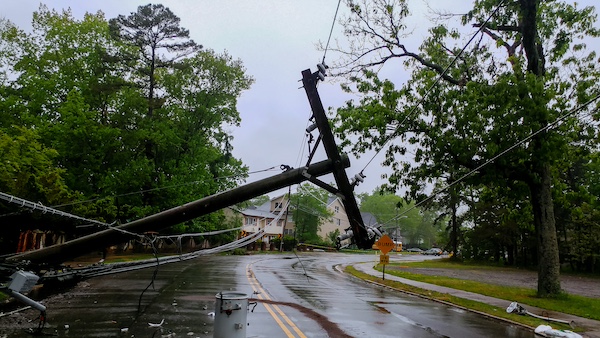On-site Generation of Wind Energy is Key to Recovery after Extreme Weather Events
When thinking of renewable energy sources, you most likely picture solar panels or massive wind turbines, churning out energy to reduce the strain on electric grids and helping towns and businesses meet lofty sustainability goals. However, when an extreme weather event occurs, these solutions alone are often not able to support recovery or restoration of power due to cloud cover, rain, flooding, excessive heat, heavy snow, or damage by debris.
Snowstorms, hurricanes, and heatwaves wreak havoc on the grid, creating nightmares for essential facilities like large warehouses, distribution and data centers, factories, and airports, all of which rely on heavy and uninterrupted power loads to sustain operations. The repercussions of power outages, brownouts, or loss of climate control can cost companies millions of dollars in lost productivity.

Extreme weather significantly impacts the power generation infrastructure, causing disruptions in electricity supply, rate escalations, limitations on and soaring costs of insurance coverage, damage to the infrastructure, and physical hazards. Considering the aging nature of our existing transmission systems, the need to diversify on-site back-up power alternatives has become more urgent and actionable.
The risk of outages not only affects other sources of remote or back-up power like diesel, propane, and coal, but these sources are not clean and sustainable solutions. In rethinking their approach to clean energy resilience, experts are prioritizing diversification of energy sources, infrastructure, and distribution, focusing more on maximizing on-site generation.
On-site solar is limited by available solar resources, and subject to seasonal and daily variations (bright summers, cloudy days, dark winters). Solar energy is typically produced mid-day and not at night or during inclement weather. Innovation in wind generation technology is creating a large opportunity to maximize on-site power as either an integrated system with solar and battery storage, or a stand-alone system where solar is not suitable.
Wind harvesting units generally produce more electricity in the late afternoon and nighttime, and during the fall and winter, offering a perfect complement to solar energy. One way to lessen the stress on national grids is to produce what you consume to keep your properties active in rain, snow and other adverse weather. Along with solar, wind energy helps site owners have a balanced load and be more independent of the grid.

Innovation in the renewable energy sector has led us to harness the power of wind for scalable, on-site generation by individual users. These units are growing in popularity and efficiency, especially in remote locations and areas where the increasing intensity of storms has escalated power outages on aging grids (and solar alone is not a viable, year-round option).
This clean energy distributed power alternative is being adopted by a growing number of companies with large manufacturing facilities and warehouses such as ecommerce, logistics, automakers, and airport terminals that require a heavy power supply — in place of traditional carbon-based fuels typically used for back-up power generation.
There have been numerous attempts to integrate wind harvesting technology into the built environment, but none without its challenges. Traditional wind turbines have been limited by environmental and visual impact constraints in the built environment. Even a smaller scale traditional wind turbine doesn’t sufficiently mitigate these legacy challenges.
As companies seek to mitigate climate change and control the input and output of energy at their facilities, experts explored ways that wind harvesting units can be deployed on buildings for individual use with the development of quieter, motionless, and more efficient wind harvesting units suitable for single buildings.

On-site power supply will become more critical to counter the more frequent, extreme weather conditions we expect to see in the future. A disruption to a single power plant during an extreme weather event would have dire consequences for a large area. However, buildings operating with their own supply of power via a wind harvesting unit coupled with solar, would be able to enhance operations by both saving on the power they consume during normal conditions, and protecting them from grid outages caused by these growing numbers of intense weather events.
In 2021 and 2022, we watched as Europe worked its way through a challenging energy crisis, where oil, coal, and power prices surged, stretching resources. Further, Europe depended on deliveries of coal and oil from Russia, which was disrupted by the country’s ongoing tensions with Ukraine. In coal-reliant South Africa, residents experience brownouts for hours each day as aging coal plants are prone to breakdowns, and new energy generation facilities are yet to be built. Companies in the Netherlands have gone back to utilizing diesel generators as backups because the national grid cannot supply the needed power any longer.
As a society, how do we solve the challenge of our reliance on electricity and carbon-based fuels? Building centralized power plants requires major and costly investments in the global grid. The world is seeing the electrification of everything – from handheld devices, cars, trucks, and even whole buildings, which means our demand for electricity will continue to increase, putting more strain on the grid. Extreme weather conditions coupled with the uptick in demand for electricity is pushing the limit of what grids can supply. Given the escalating frequency of extreme weather events around the globe, it’s more important than ever to seek alternative methods of energy production.
Development of new on-site power generation systems are highly necessary to adopt and strategically implement. Distributed resources are the new frontier. New innovations are required to drive the scalability of the energy transition and establish the level of resilience necessary based on the dramatic impacts of extreme weather.
Claus Lønborg is Managing Director at Aeromine Technologies, which helps building portfolio owners and companies reduce CO2 emissions by deploying local wind energy systems to the commercial and industrial real estate segment.
Aeromine Technologies | aerominetechnologies.com
Author: Claus Lønborg
Volume: 2024 May/June








